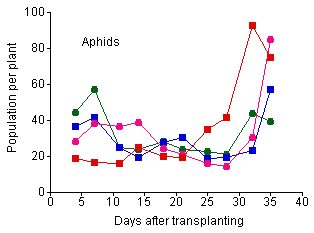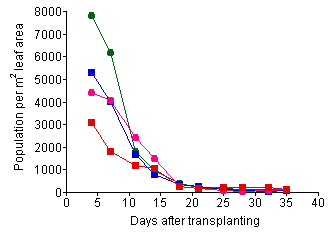The abundance of insect pests is expressed as the density per
plant in most cases. This measure, however, is not always an appropriate measure
of density, since the size of a plant varies greatly with its growth stage. To
evaluate the importance of selecting an appropriate measure of density, the dynamics
of the density of cabbage pests per leaf area was compared with that per plant.
The leaf area was continuously estimated in the field in a noninvasive manner,
using the allometric relationship between leaf area and leaf length. Density per
leaf area and density per plant showed widely different dynamics in some herbivores.
Aphid density per plant increased gradually with the growth of cabbages, while
aphid density per leaf area decreased with cabbage growth, suggesting that injury
by aphids was more severe in the early stages of plant growth. The larval density
of the diamondback moth, Plutella xylostella (Linnaeus), per plant increased
with cabbage growth, while the density per leaf area showed a peak level at 15
days after transplanting. Such differences suggest that population dynamics measured
per plant may sometimes be a misleading description of actual insect-plant interactions.
(Copyright by the Japanese Society of Applied Entomology and Zoology)
 |
 |